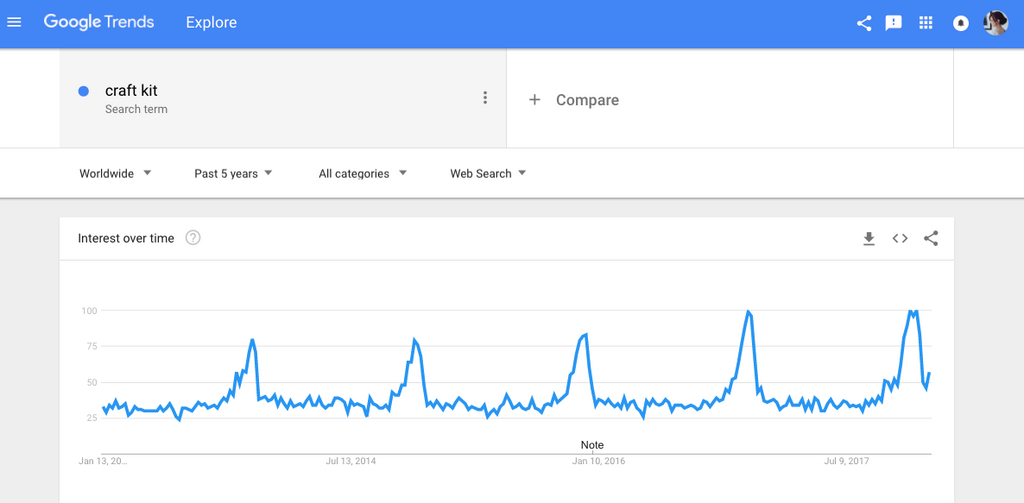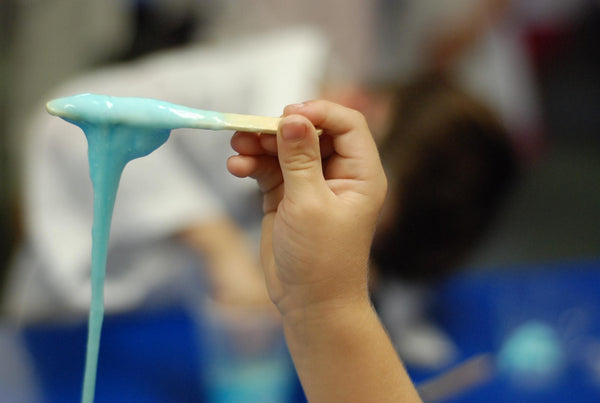As a kid, you likely tinkered with one form of craft kit or another. Whether it was a loom kit that allowed you to create a custom beaded creation, an art kit that helped you paint-by-numbers, or a model kit for building your favorite jet, many of us have some experience with these creations in a box.
And those craft kits are coming back with a vengeance — and with many new iterations. With the rise of inspirational platforms like Pinterest, crafting has seen a huge boost in popularity. Crafting is no longer a kitschy hobby — DIYing is having a moment right now. And because of this rising trend, there are ample business opportunities for savvy hustlers.
Creating your own craft kits for children and adults alike can stoke your creative fire while also offering a hot product for eager crafters.
Ready to hear more about building craft kits into a business? Let’s take a look at the product’s prospects, examine some examples, and highlight how you can get started selling.
Why Craft Kits?
While craft kits are certainly nothing new, there is steady interest online in these products. If you take a look at the topic in Google Trends, you’ll notice that search queries have stayed consistent over the last few years with regular spikes in interest in the lead up to the holiday season:

Besides the popularity and consistent interest, craft kits also boast a number of other benefits as a product:
- You can customize your kits: As I previously mentioned, there are dozens of different types of craft kits. You can hone in on selling just one type, or offer a variety within a specific niche (i.e. painting kits, sewing kits, etc.).
- Low startup costs: Depending on the type of kits you choose to build and sell, you don’t need a mountain of startup capital to get started. You can acquire ingredients/pieces for kits inexpensively through wholesale sites.
- You don’t need to be a DIY master yourself: Just because you’re marketing and selling products to DIYers doesn’t mean you need to be a master crafter. Assembling craft kits doesn’t require that you be crafty yourself — you just need a little creativity and some guidance.
Because of the flexibility and personalization possibilities of craft kits, it’s easy to see their appeal as a product. Now, let’s dig into some different types of craft kits and some successful examples to inspire you.
Types of Craft Kits
There are innumerable variations on craft kits, so we’re just going to take a look at some of the most popular versions that you can easily customize yourself to sell.
Slime Kits
At first glance, this may sound like a messy craft kit to assemble. Slime kits are a hot product with children these days, as you can see from recent Google Trends data:
 Slime is best described as a squishy, gooey substance that’s easily created from common household ingredients.
Slime is best described as a squishy, gooey substance that’s easily created from common household ingredients.
 Image: Flickr
Image: Flickr
Using a trio of basic ingredients, savvy craft kit creators can build slime kits for eager, young chemists-in-the-making.
All you need is:
- Craft glue
- Borax
- Warm water
You can then personalize your slime kit by optional ingredients like glitter, food coloring, confetti, and other craft supplies. Here’s a basic slime recipe to help you create your slime craft kits.
To create your slime kit, you just need to measure out each ingredient, place in separate, airtight containers, and assemble it all in a box for shipping.
One example of a crafty entrepreneur who has capitalized on this trend with her own slime kit is YouTube sensation Karina Garcia.
After collecting many millions of views on her YouTube channel (which focuses exclusively on making slime), she created her own slime kit brand Craft City. Her line of slime kits currently sell at Target stores and on Amazon.
Lip Gloss/Lip Balm Kit
Another craft kit that is relatively simple for aspiring entrepreneurs to assemble is a lip gloss kit (or a lip balm kit).
Again, this is a product that has risen in popularity over the last few years — and the simple ingredients needed to create lip gloss or balm make it ideal to turn into its own craft kit.
 While there are a number of recipes available, many of the natural lip care recipes include the same basic ingredients that are all inexpensive to purchase:
While there are a number of recipes available, many of the natural lip care recipes include the same basic ingredients that are all inexpensive to purchase:
- Beeswax
- Oil of choice (many use shea butter and/or coconut oil)
- Essential oil of choice
- Lip color/lipstick for color
For a basic recipe you can replicate and build upon, try our guide to turning natural lip care into a homemade business.
Huckleberry is a great example of a merchant successfully selling beautifully packaged homemade lip balm kits.
Other Craft Kit Ideas
The aforementioned craft kits are simply two popular options for eager entrepreneurs to explore. If neither piques your interest, never fear — we’ve rounded up a few other alternatives for you to consider.
There are a number of other iterations of craft kits you can use for your business, including:
Where to Source Ingredients and Equipment for Craft Kits
To make your craft kit dreams a reality, you’ll need to source all your materials. And to make your business financially viable, those materials can’t be overpriced.
While the ingredients and equipment you’ll need will differ depending on the type of craft kit you choose to sell, here are some general places you can find everything you’ll need:
- Raw Materials: For materials like glycerin and beeswax, grab a bulk amount from a marketplace like Bulk Apothecary or Etsy.
- Bulk Containers: For molds, small plastic bottles for separating ingredients, plastic baggies, and other bulk containers, try AliExpress.
- Miscellaneous Materials: For mixing materials, measuring cups, and similar equipment, try your nearest dollar store and/or craft store for supplies.
- Packaging: Depending on the type of craft kit you choose, try a supplier like ULine for boxes and packing supplies. Or opt for a provider like Sticker Mule for branded poly mailers.
How to Market Your Craft Kit Business
Selling Your Craft Kit Online
Now that you’ve gathered the basic elements to create your own craft kits, you’re almost ready to sell your creations.
To get as many eyeballs on your products as possible, you’ll want to consider multiple marketplaces. Taking to the Internet is one of the first viable options to explore. There are several digital channels that can help you get started, like an ecommerce store and Amazon.
Use a variety of digital marketing platforms and tactics, you can draw traffic to your store and build a loyal following. That way, merchants can discover what platform and tactics work best to convert browsers into buyers.
While this isn’t a complete list of all the channels merchants can explore for their business, these are viable options to examine when creating a marketing plan.
- Instagram: Use this visual social media platform to build a large following. Cultivate a relationship with brand evangelists, provide a behind-the-scenes glimpse at how you created your terrariums, and create gorgeous images that show off your products.
- Pinterest: Home décor is a particularly active category on Pinterest (I should know, as I have three boards dedicated to conflicting interior design visions). As such, merchants selling terrariums should consider the platform to find new customers.
- Snapchat: While Snapchat is a relative newcomer compared to the other major social media platforms, it’s one of the fastest-growing around with a user base of more than 200 million. Those kinds of numbers have caught the attention of many businesses, and many more merchants are looking to reach their target customers through this channel.
- Giveaways and Contests: Set aside a few terrariums and offer them as prizes in a branded giveaway or contest. Yes, you may be giving away some of your products, but contests offer the chance to increase your customer base, introduce your products to new customers, and grow your business as a result.
- Email Marketing: You can reach people right through their inboxes with targeted email campaigns. Offer subscribers and customers great deals, promotions, and business news to help move them along in the buyer journey.
💡 PRO TIP: Want to create beautifully branded emails to promote your next craft kit launch? Use Shopify Email to create, send, and track campaigns, all from within Shopify—no coding experience required.
Selling Your Craft Kits Offline
While selling online offers a global avenue for you to sell your unique creations, don’t discount the ability to sell in person.
Because terrariums are small and travel well, consider selling your tiny gardens at markets and fairs. Setting up a market booth or a pop-up shop allows small businesses the chance to test out their products on the public and get live feedback without being forced to shell out high rental rates for a stationary storefront. And temporary retail locations give merchants to chance to sell anywhere, anytime.
Merchants who sell at fairs and markets can also meet other talented makers, crafters, and entrepreneurs who can offer their inspiration and advice from their own business journey.
Not sold on selling in person? Here are more reasons to consider when weighing the option to make physical sales:
- Test out products in person for live feedback: Potential customers have the chance to experience the terrariums right in front of you — take the chance to address their questions and concerns. Markets and fairs are live testing grounds, so use them to address customer pain points and use the feedback to create or improve future products.
- Find wholesale customers: Looking for potential wholesale relationships with other retailers? Markets and fairs are great places to forge these relationships.
- Build a more robust social following or email list: More popular fairs, festivals, and markets will send you dozens of visitors to your booth. So, encourage them to follow your branded social channels and/or subscribe to your enewsletter to keep them in the loop about news, discounts, or contest.
While selling in person is a different beast from selling behind a computer screen, the right know-how and equipment can make it easier to take transactions on the go. Using a mobile point-of-sale system like Shopify POS, you can set up shop and hawk your freshly made wares at flea and farmer’s market, craft fairs, and/or maker fairs.
If you’re keen to sell your products IRL (in real life, of course), read our guide to nailing the in-person selling experience.
Ready to Start Your Own Craft Kit Business?
Now you have the info to get started with a viable business that also scratches your creative itch. It’s time to move forward and start selling!
Read more
- A Retailer's Guide to Sustainability: How to Make Your Store More Sustainable
- The Future of Retail Staff: How Is the Role of the Retail Worker Changing?
- Why Retailers Can’t Ignore The Power Of Sound: Building a Sonic Strategy for Your Store
- Why People Buy: 5 Aspirational Marketing Tactics for Retail Brands
- Inflation in Retail: Everything You Need to Know
- Augmented Reality in Retail: How Retailers are Using AR for Better Shopping Experiences
- Do Retailers Need a Digital Fashion Strategy? 5 Brands Designing for the Metaverse
- Complete Retail Automation Strategy Guide for 2002





